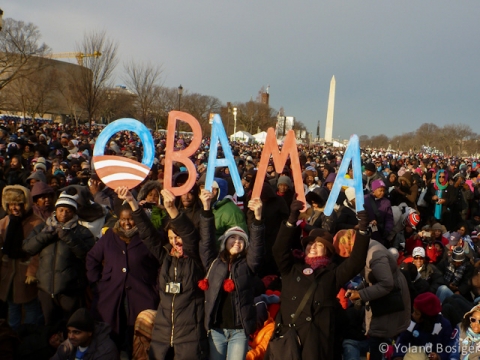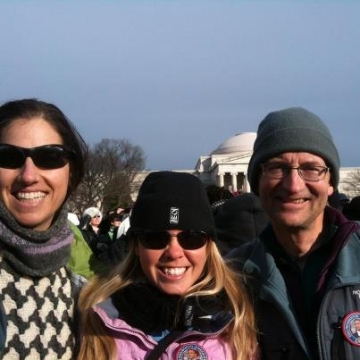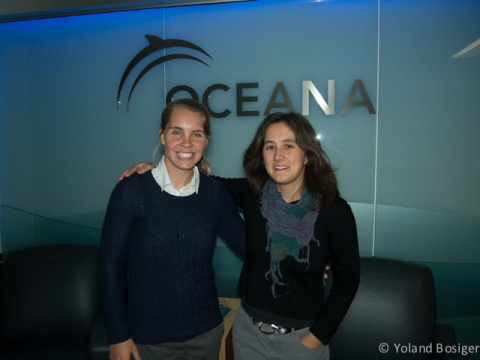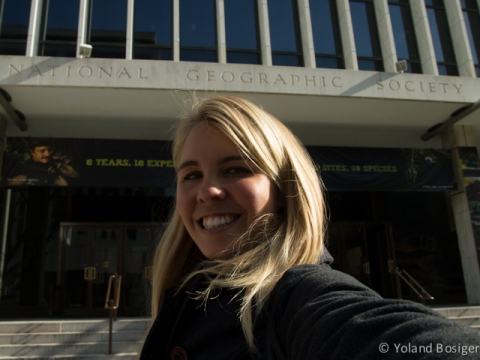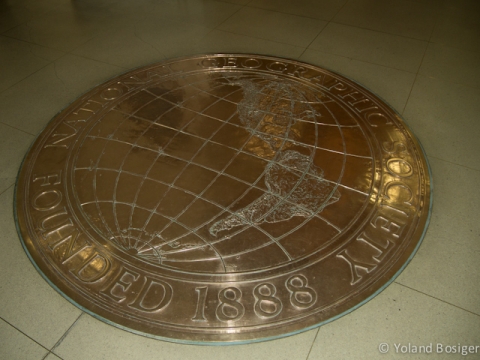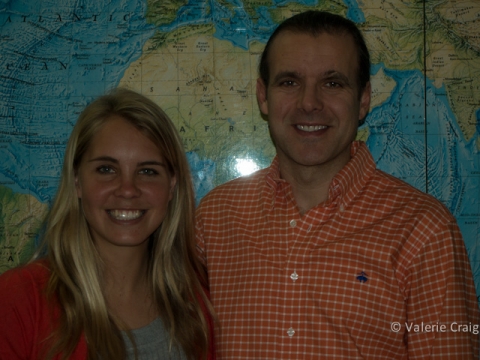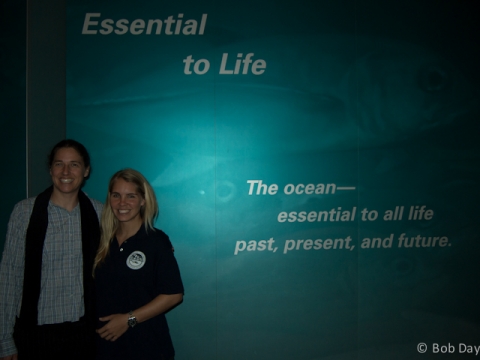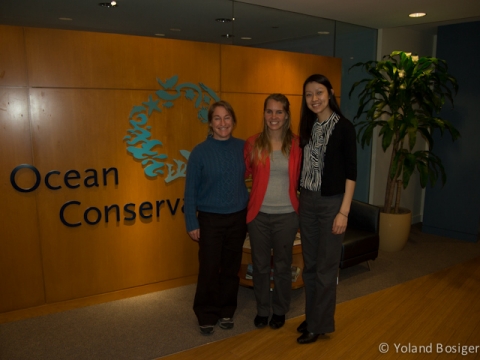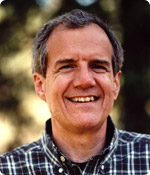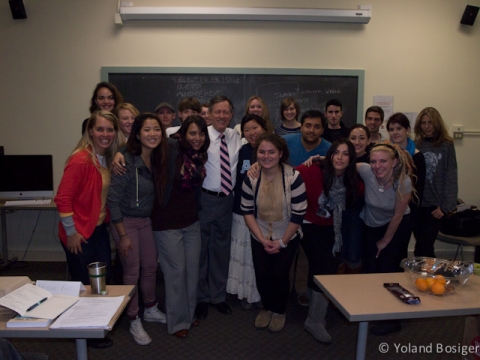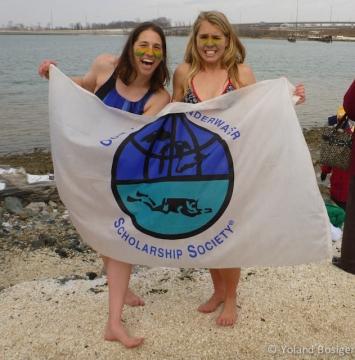“We, the people, still believe that our obligations as Americans are not just to ourselves, but to all posterity. We will respond to the threat of climate change, knowing that the failure to do so would betray our children and future generations”.
The inspirational words of newly elected President Barak Obama rang out clearly from the Presidential Place. While most were watching this historic moment from the comfort of their homes, Alison LaBronte, Bob Day and I were able to see it in person. We may have been a couple of km back but hey, it was pretty remarkable to watch even for a very out-of-place Aussie. I’ll never forget all the spirit and anticipation that was in the air that day!! See full speech here.
My main motivation for coming to Washington DC was to volunteer with different conservation organisations and get some experience with marine policy. With the help of North West Coordinator Alison LaBronte, Dave Colin and Robin Parish, I visited a huge range of government and non-government institutions and met with a diversity of leaders in marine conservation, policy and filmmaking.
The first week began with meeting some of the team at Oceana. Margot Stiles filled me in on the major departments at Oceana including Science, Law and Policy, Media, Marketing and Advertising and fundraising. One of unique campaigns I got to hear about at Oceana was seafood fraud. Recent studies have found that seafood may be mislabeled as often as 25 to 70 percent of the time in the US. Oceana is working to combat the problem by promoting traceability systems and preventing seafood mislabeling. For more information see: http://oceana.org/en/our-work/promote-responsible-fishing/seafood-fraud/learn-act. Thanks also to Beckie Zisser, Eric Bilsky, Amanda Keledjian, and Jessica Wisman for also having a chat to me.
National Geographic followed that week and I had the privilege of meeting some of the Ocean Initiative team, namely Valerie Craig, Enric Sala and Miguel Jeorge. Valerie and Miguel’s mission at National Geographic is to get people more connected to the ocean in their daily lives. Using a range of innovative ideas and techniques, National Geographic’s Ocean Initiative aims to raise awareness of the importance of marine protected areas and sustainable fisheries. For instance, National Geographic is collaborating with popular Chef Barton Seaver, an expert in cooking sustainably who will be helping to spread awareness of healthy and enviro-friendly meal options. The Oceans Initiative is also working to identify, support and reward individuals and organisations that are using creative approaches to promote greener and more sustainable seafood. See: http://ocean.nationalgeographic.com/ocean/ocean-innovators/
One of the really amazing things I got to do in Washington DC was meet National Geographic Explorer in Residence and Chief Scientist on the Pristine Seas Expeditions, Enric Sala. Running since 2005, the Pristine Seas Project aims to raise awareness, provide key scientific data to inform policy, and inspire political leaders to preserve the worlds pristine places. So far their have been 6 expeditions with the 7th currently underway in the Desventuradas Islands, just off the coast of Chile aboard with the Undersea Hunter Group’s Argo and DeepSee Sub. Enric gave me two very good pieces of advice during my meeting with him. If you want to be an Explorer you need firstly gain the credibility that will make people listen to you. Second, learn to communicate!!!
At the end of the week I met with KerryLynn Miller at the Pew Charitable Trusts Shark Conservation Group. KerryLynn organised a meeting with everyone in the group and I got to hear all about how the team operates. As one of the few non profits with a dedicated shark conservation group, Pew has been heavily involved in setting up Shark Sanctuaries in many island nations, including the one in Palau which I visited earlier this year. As a primarily policy driven organisation, the Pew Shark Conservation Group sets up regional workshops to promote shark conservation and is active at both regional fisheries meetings and international conventions. Fingers crossed for CITES!
During my stay in Washington DC, Alison and Bob took me to the Smithsonian National Museum of Natural History. We spent the afternoon exploring the Ocean Hall and I was amazed at the spectacular exhibits – I wish had have had more time to explore it!! While at the Museum I also got to meet with Nancy Knowlton who is currently the Sant Chair for Marine Science at the Natural History Museum. Having worked at Scripps, Yale and the Smithsonian Tropical Research Institute, Nancy had a truly amazing career as a biologist. Now largely based at the Museum, Nancy is heavily involved in raising awareness for the plight of the ocean and has been busy helping to set up and design the Smithsonian Oceans Portal – an incredibly informative site about the ocean. To here more from Nancy see: www.youtube.com/watch?v=iwdTnqGUn10
Thanks to Alison’s neighbor, Bernadette I was able to spend one week at Ocean Conservancy learning all about Marine Spatial Planning with Anna Zivian and Carmen Yeung. I got to do a range of different tasks at the Ocean Conservancy from conducting research on “potentially ecologically minded” congressmen to summarising research abstracts into plain and easy to understand language – an extremely useful skill if perfected!!
On the advice of KerryLynn Miller, I then went to meet Mr Steve Roady, a ocean lawyer for Earth Justice. Steve is literally what I always aspired to be – someone who stands up and fights for the ocean. For over 14 years, Steve has been litigating cases that have set important precedents for how the Federal Government manages ocean resources. Steve is currently working on a case which challenges the National Marine Fisheries Service and Secretary of Commerce decision to allow fishing of parrotfish in the Puerto Rico and U.S. Virgin Islands. By allowing the parrotfish to be overfished, the Plaintiffs are arguing that the NMFS and SOC failed to protect threatened corals, currently protected by the Endangered Species Act. Parrotfish play an important role in ensuring healthy coral reef ecosystems by removing fast growing algae. Without healthy numbers of herbivores like parrotfish, corals can become smothered eventually causing a Phase Shift from a coral to algal dominated state see: http://www.ted.com/talks/jeremy_jackson.html. Meeting Steve and hearing about how Earth Justice is using environmental laws to protect coral reefs was definitely a highlight of my Washington DC adventure. Photo courtesy of Earth Justice.
Thanks to David Conlin, I was then off to meet NOAA employees, Valerie Grussing, Frank Cantelas and Ole Varmer. Valerie is the Cultural Resources Coordinator in the National MPA Centre and maintains partnerships between agencies, states and indigenous tribes regarding protection of cultural resources. Frank, on the other hand works as an employee at the NOAA Office of Exploration, which overseas the NOAA ship, Okeanos Explorer. This ship is well known for discovery and for using innovative telepresecnce to communicate to scientists (who are often land based) and the general public. See: http://oceanexplorer.noaa.gov/okeanos/welcome.html. Ole Varmer then filled me in on his work as a international marine lawyer at NOAA. Ole work is diverse and has ranged from drafting US Marine World Heritage proposals to thinking of ways to protect the Sargasso Sea (a giant moving patch of Sargassum in the middle of the North Atlantic Ocean). Not only is this sea in international waters but it also moves –a legal nightmare for some, but definitely an interesting and exciting challenge for Ole Varmer.
I’ve really enjoyed trying my hand at underwater videography this year and so when Chris Palmer, Director of the Centre for Environmental Film Making, offered me to come and join his class at the American University, I was thrilled. Chris is by far the most animated and excitable lecturer I have ever had and I enjoyed ever minute of the class. I also came away feeling like I knew a lot more about the production process.
Finally as my three weeks came to a close, I finished up with a Polar Punge into the chilly Potomac with Alison LaBronte. The Plunge is organised by the Chesapeake Climate Action Network and raises awareness for climate change.
Thanks so much to Alison and Bob for having me and particularly to Ally who did the most amazing job helping me organise my trip. Thanks also to Cathy and Abe (Alison’s neighbours who looked after me in the first couple of days). Finally, thank you so much to those people who did not yet get a mention and gave up their time to see me: Whitney Tome from the Environmental Defense Fund, Suzanne Garret from the IUCN, Arthur Binkowski, Director of Virtual Studios at National Geographic, Mr Jim and Pam Corry who had me for dinner, and all the people at the Women in Conservation Group that I met thanks to Rachel Keylon and Amanda Keledjian.

